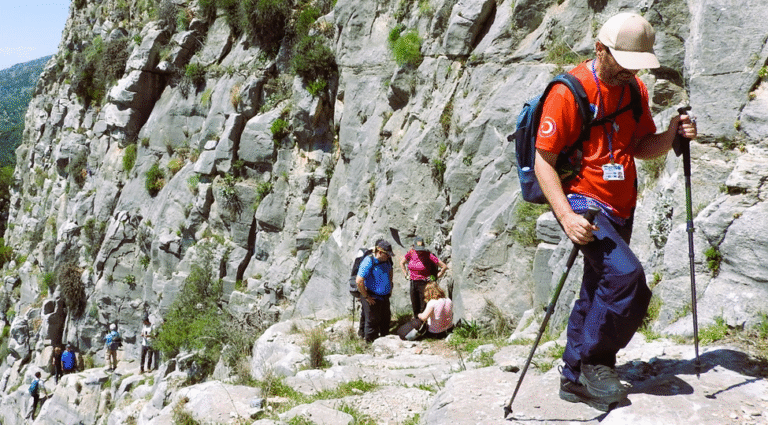
A compass is an important tool for navigation when hiking or traveling. In fact, it’s a must-have tool to navigate efficiently. Moreover, learning to use a compass can enhance your safety. Therefore, following the components will help you navigate using a compass effectively.
Understanding the Parts of a Compass
It’s important to remember the following compass components:
Scales/Rulers: The markings on the base plate that are used to measure distances on a map are called scales or rulers.
Direction of Travel Arrow: The base plate has a direction of travel arrow that indicates which way you should go.
Declination Scale: The declination scale is a tool used to account for the difference between true and magnetic north.
Rotating Bezel: A circular dial with 360° indications, that is used to set bearings is called a rotating bezel.
Housing: The clear, round container that contains the liquid and magnetic needle.
Orienteering Lines: Orienteering lines are parallel lines that line up with map grid lines inside the compass housing.
Bearing (Index) Line: A fixed line inside the bezel that shows the bearing reading is called the bearing (Index) line.
Orienteering Arrow: The compass is oriented to the north using the orienteering arrow, a sizable red arrow located inside the housing.
Magnetic Needle: A rotating needle that is magnetized and points in the direction of magnetic north is called a magnetic needle.
Base Plate: The compass’s transparent, flat base that has markings and rulers for usage on maps.

Holding the Compass Correctly
First, hold the compass flat in your hand. Next, make sure it’s level. If it’s tilted, the needle won’t move freely. Finally, the red end should always be visible and pointing north. When you’re navigating keep the compass near to your body and keep metal objects away.
Metals can interfere with the needle’s accuracy, especially when you navigate using a compass near electronic devices or vehicles.

Finding North with a Compass
Use these steps to locate north:
1. Keep the compass stable and flat.
2.Turn the needle until its red end lines up with the orienting arrow.
3. At that point, the direction-of-travel arrow will be pointing north.
Keep in mind that this is not real north; rather, it is magnetic north. Additionally, depending on the region, magnetic north varies slightly. We refer to this gap as declination. Therefore, when using a compass to navigate in regions with substantial magnetic variation, you need to be aware of this.

Setting Your Direction or Bearing
- A compass provides you a guide to a specific direction. This is called a “bearing.”
- Turn the rotating bezel until your desired direction is at the top.
- Hold the compass flat and steady.
- Rotate your body to line the needle with the orienting arrow. The direction-of-travel arrow now points to your destination.
- Take note of this direction. Look for a landmark in that direction and walk towards it to navigate confidently.
Using a Map with a Compass
Navigation becomes more accurate when you have a map next to your compass. They complement each other in the following ways:
1. Place the map so that it is level.
2. After positioning your compass on the map, connect your starting and destination points using the baseplate edge.
3. Turn the bezel so that the north-south lines line up with the north on the map.
4. Line up the needle with the orienting arrow while holding the map and compass together.
5. By displaying your route, the direction-of-travel arrow will make it easier for you to navigate with a map and a compass.
Adjusting for Magnetic Declination
- Maps are drawn for “true north,” not magnetic north. Declination accounts for this difference.
- Check the map’s declination information. Then, adjust your compass.
- If you’re west of the zero-declination line, add degrees. If east, subtract them.
- Most compasses allow for easy declination adjustment. Check your compass manual if needed to navigate using a compass with accuracy.
Most compasses allow for easy declination adjustment. Check your compass manual if needed to.
Using Your Compass in the Field
With practice, compass skills get better. The following advice is for field use:
1. Have Faith in the Needle: The needle is aware of the north. Check it whenever you’re not sure.
2. Seek out landmarks: Observe objects in your path, such as rocks or trees.
3. Verify your bearing again: To prevent shift off course, periodically double-check.
4. Steer clear of metal: Keep watches and other metal objects away from the compass. You’ll eventually gain the self-assurance when navigate using a compass even in difficult situations.
Troubleshooting Compass Problems
A compass can present some challenges when you navigate with it. Here are some frequent concerns and solutions: For example, nearby metals or electronics can disrupt the needle’s accuracy. In that case, double-check and move to a different location.
1. If the needle becomes stuck, gently tilt the compass to assist with realignment.
2. Old compasses can lose their magnetism. Replace them if they are unreliable.
Practicing Your Compass Skills
Learning how to use a compass involves practice. Begin by taking the easy paths. In well-known locations, use a compass and a map. Soon, you’ll gain confidence and abilities.
Try these exercises:
1. Establish a bearing and walk small distances.
2. Combine Compass and Map Reading: Learn to identify directions on a map and then walk them.
3. Use a compass to locate visible landmarks as you navigate using a compass on various terrains.
Why Compass Navigation Matters
A compass doesn’t rely on batteries or signals. Therefore, it’s more reliable than GPS in remote areas. Additionally, learning to navigate with a compass could save you in an emergency. Plus, it builds your outdoor skills and confidence.
Consequently, navigating with a compass is simple with practice. First, understand your compass, align the needle, and follow your bearing. If needed, adjust for declination. In conclusion, the compass is an age-old tool, but it remains powerful for exploration.
FAQ’s
How to Navigate Using a Compass?
How do I set a compass bearing?
What is declination, and why is it important?
How do I follow a bearing once it’s set?
Can a compass work anywhere?
How do I use a compass with a map?






